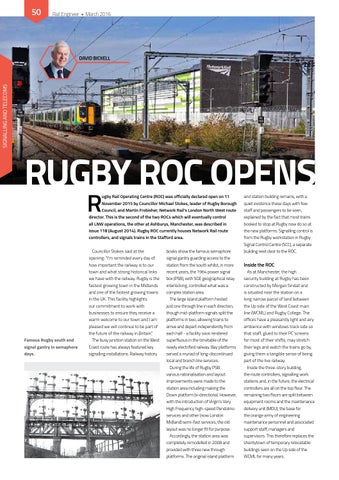50
Rail Engineer • March 2016
SIGNALLING AND TELECOMS
DAVID BICKELL
RUGBY ROC OPENS R
ugby Rail Operating Centre (ROC) was officially declared open on 11 November 2015 by Councillor Michael Stokes, leader of Rugby Borough Council, and Martin Frobisher, Network Rail’s London North West route director. This is the second of the two ROCs which will eventually control all LNW operations, the other at Ashburys, Manchester, was described in issue 118 (August 2014). Rugby ROC currently houses Network Rail route controllers, and signals trains in the Stafford area.
Famous Rugby south end signal gantry in semaphore days.
Councillor Stokes said at the opening: “I’m reminded every day of how important the railway is to our town and what strong historical links we have with the railway. Rugby is the fastest growing town in the Midlands and one of the fastest growing towns in the UK. This facility highlights our commitment to work with businesses to ensure they receive a warm welcome to our town and I am pleased we will continue to be part of the future of the railway in Britain.” The busy junction station on the West Coast route has always featured key signalling installations. Railway history
books show the famous semaphore signal gantry guarding access to the station from the south whilst, in more recent years, the 1964 power signal box (PSB), with SGE geographical relay interlocking, controlled what was a complex station area. The large island platform hosted just one through line in each direction, though mid-platform signals split the platforms in two, allowing trains to arrive and depart independently from each half - a facility soon rendered superfluous in the timetable of the newly electrified railway. Bay platforms served a myriad of long-discontinued local and branch line services. During the life of Rugby PSB various rationalisation and layout improvements were made to the station area including making the Down platform bi-directional. However, with the introduction of Virgin’s Very High Frequency high-speed Pendolino services and other (now London Midland) semi-fast services, the old layout was no longer fit for purpose. Accordingly, the station area was completely remodelled in 2008 and provided with three new through platforms. The original island platform
and station building remains, with a quiet existence these days with few staff and passengers to be seen, explained by the fact that most trains booked to stop at Rugby now do so at the new platforms. Signalling control is from the Rugby workstation in Rugby Signal Control Centre (SCC), a separate building next door to the ROC.
Inside the ROC As at Manchester, the high security building at Rugby has been constructed by Morgan Sindall and is situated near the station on a long narrow parcel of land between the Up side of the West Coast main line (WCML) and Rugby College. The offices have a pleasantly light and airy ambience with windows track side so that staff, glued to their PC screens for most of their shifts, may stretch their legs and watch the trains go by, giving them a tangible sense of being part of the live railway. Inside the three-story building, the route controllers, signalling work stations and, in the future, the electrical controllers are all on the top floor. The remaining two floors are split between equipment rooms and the maintenance delivery unit (MDU), the base for the orange army of engineering maintenance personnel and associated support staff, managers and supervisors. This therefore replaces the shantytown of temporary relocatable buildings seen on the Up side of the WCML for many years.
